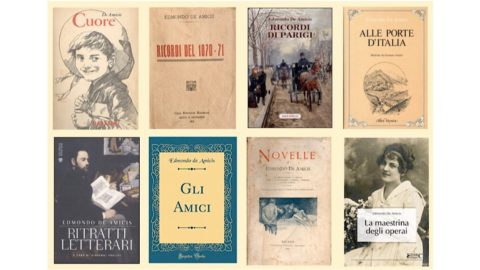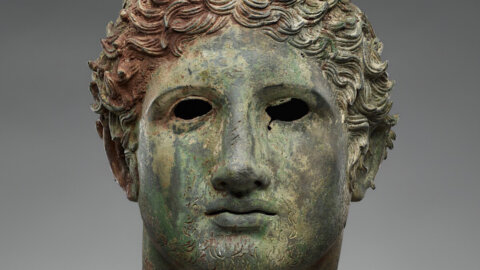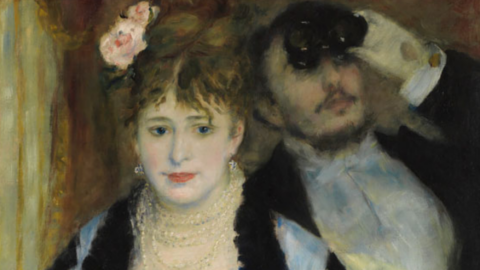However, if there is an adjective that proves to be unsuitable to qualify the person from which it is taken, this is precisely the first meaning of the adjective, meaning with "deamicisiano" that something moralistic, pathetic and tearful, pervaded by good feelings , which can even lead to saccharine and saccharine tones.
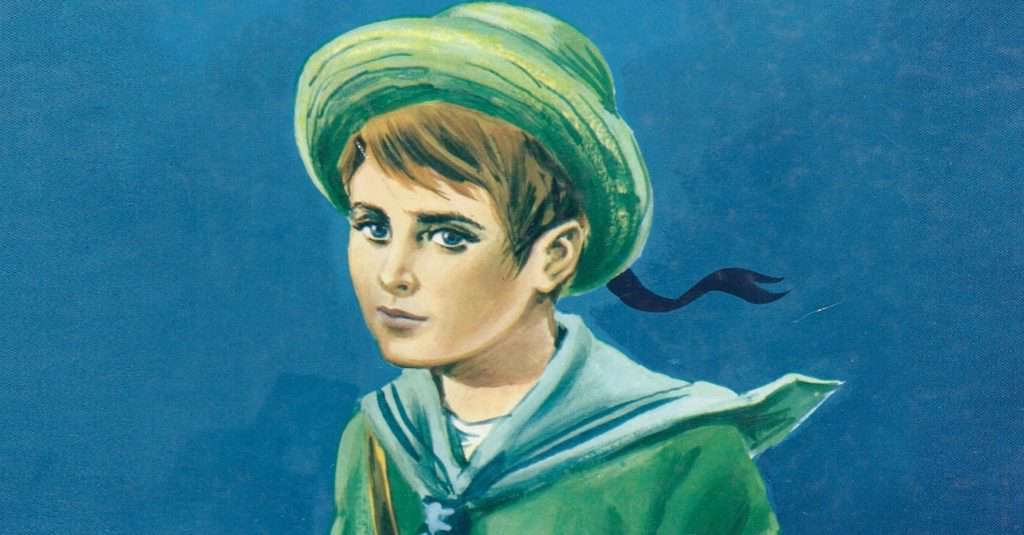
De Amicis was anything but, and that attribute, like the nickname that Carducci poisonously coined, “Edmondo dei languori”, does not do him justice at all.
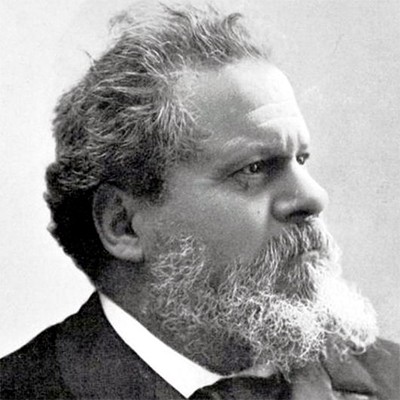
It is due to Giosue Carducci, the poet bard dell'Italietta, the liquidation of the work of De Amicis.
His most famous book, Heart, on which entire generations of young and old were trained from the end of the nineteenth century until the sixties of the twentieth century. And if that highly successful book partially justifies that adjective, it must be remembered that De Amicis was much more and much more, and labeling him in that way appears reductive and partial. And all in all deeply unfair. Because our author has composed very different books, he has shown himself concrete and careful in managing his life and his affairs with publishers, in a period in which there were neither literary agents, nor role models to inspire products of their own ingenuity.
It is enough just to see what the writers of his time did in similar circumstances, from Collodi to Manzoni, from Salgari to Invernizio: all either shamefully underpaid or even failed in managing their own works.
A skilled manager of his artistic creativity
De Amicis, on the other hand, has been able to juggle relations with publishers more than well, showing a concreteness and business acumen that have nothing of the inexperienced. Furthermore, he was a valuable journalist, a skilled special correspondent who told the Italians, before and better than others, about places, countries and both national and international realities.
Finally, he was a writer who was very attentive to social problems, to the condition of the weakest, to that of our migrants, well represented by him in some works, something not usual at the time, indeed extremely rare. In one of his last compositions, First of May, has even arrived at a type of socialism that a great intellectual and scholar like Sebastiano Timpanaro did not hesitate to define as "scientific".
You can clearly see how there is very little of "Deamicisiano" in all of this.
The life
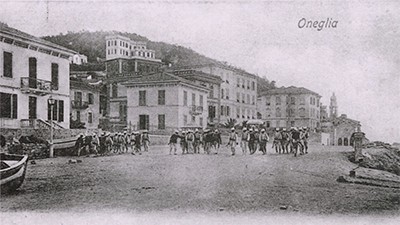
A postcard of the city of Oneglia, in the province of Imperia, at the turn of the XNUMXth century
He was born in Oneglia (Imperia) in 1846 into a wealthy family, the youngest of six children. His father Francesco is a "royal banker of salts and tobacco", which means wholesaler of these state monopoly goods to resell them to retailers. After completing high school, instead of undertaking university studies like his older brother Tito, due to his father's illness he entered the Military Academy of Modena at the age of 17, in order to be able to count on a secure salary.
Two years later he came out with the rank of second lieutenant, just in time to participate in the Third War of Independence. He fights as aide-de-camp to the future King Umberto of Savoy in the ruinous battle of Custoza, where our troops, numerically much superior to the Austrian ones, are blatantly defeated.
The lost war feeds fierce controversies on the unpreparedness and inadequacy of our army, which are reflected in some works of the period, including A noble folly by Iginio Ugo Tarchetti. To counter the climate of distrust towards the army, the military leaders created a magazine "Military Italy", with the aim of improving the image of our armed forces. For a short time De Amicis will also be called to direct it.
His first success: Military life
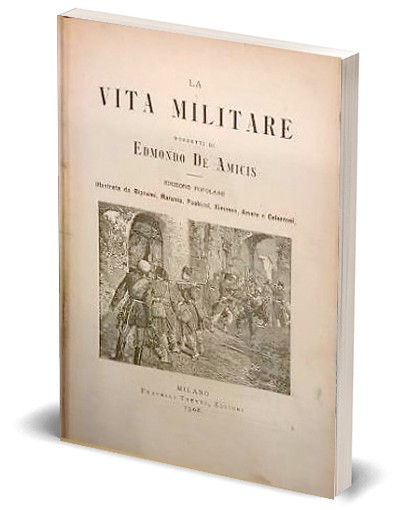
The first edition of 5000 copies de Military life, published by Le Monnier, sells out in less than a month.
His stories have appeared in this magazine since 1867, and readers immediately like them. So a young Milanese publisher Emilio Treves, who started his business a few years ago and who is looking for a book of a certain success to make himself known in the environment, asks De Amicis to be able to print his sketches in volume.
Thus, in 1868, the first edition of the Military life in 5.000 copies, a figure to be considered almost risky at the time, but justified both by the favor with which the stories in the magazine had previously been received, and by the support that the armed forces would have reserved for the work. And in fact Treves' predictions turned out to be not only spot on, but even lower than the public's demand, so much so that the 5.000 copies sell out in just one month.
There is talk of a second edition, but the shrewd De Amicis does not entrust it to the new Milanese publisher, but to the more famous and pompous Franco-Florentine publisher Felice Le Monnier, one of the major nationally, who could give more visibility to the book, and which also had the advantage of being located a short distance from the building of Sant'Apollonia in Florence, from where the young lieutenant directed the military review.
This second edition comes out in 1869, expanded with the addition of eight other stories, and is also very successful, so much so that an edition for schools will also be obtained. Until 1880, several thousand copies were sold, over 20.000, when De Amicis decided to publish another edition, the definitive one, this time again with Treves, which in the meantime had greatly expanded and outclassed Le Monnier.
Call him a Deamicisian like that, one might say!
Of this definitive edition, several tens of thousands of copies are still printed. If we then consider the various versions of the work, such as the valuable ones, the illustrated ones, the popular ones, the school ones, as well as the illegal editions, it is estimated that 200.000 copies have been reached.
Military life it is therefore a large-scale success for the time, obviously much less than what De Amicis would later achieve with Heart, but of such an entity that we do not know which other books may have surpassed him in this part of the late nineteenth and early twentieth century.
Journalist and writer
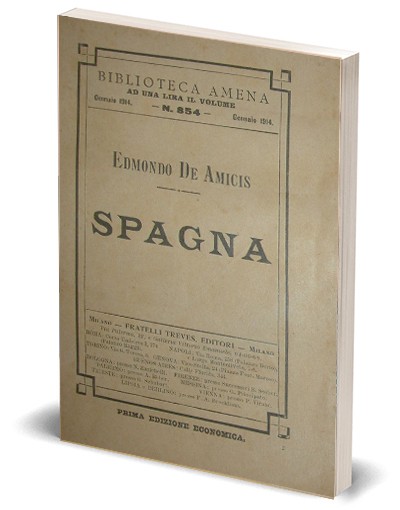
After leaving the army in 1871, De Amicis devoted himself to journalism. He writes in the “Nazione” of Florence and in the “Illustrazione Italiana” of Treves, where his services as special envoy appear in particular in various European and non-European locations. From those articles, enriched and embellished with information on uses, customs, traditions and history, he obtains volumes, which introduce those countries to our local readers and which achieve great sales success, starting with Spainreleased in 1872, followed later by Memories of London e Holland in 1874, from Morocco in 1876, from Constantinople in 1877, finally from Memories of Paris in 1879.
In the same period De Amicis composed other works, before the resounding success of Heart, as Memories of 1870–71 e Short story in 1872, Scattered pages in 1874, Poems e Literary portraitsin 1881, Friends in 1883, At the gates of Italy in 1884, which lead his name to excel in the editorial rankings.
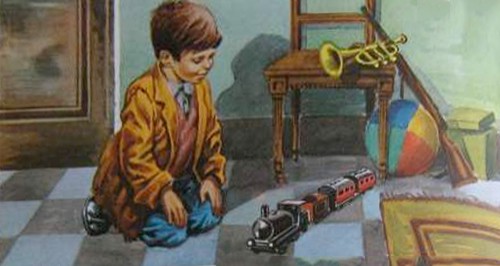
“Precossi was enchanted in front of the railway train, with the car that goes by itself, to give it the rope; he had never seen any; he devoured those red and yellow wagons with his eyes ”. This is how De Amicis describes the astonishment of the unfortunate pupil Pietro Precossi in front of technology, in an episode, "Il vaporino"," of Heart. The illustration by Giancarlo Castellani and on p. 74 of the Giuseppe Malipiero edition of 1966.
Heart
On October 15, 1886, the first day of school in those distant and happy times for students who had exactly one month of holidays more than today, Heart, the book that would break all sales records and establish itself as one of the greatest publishing successes of all time, immediately behind Pinocchio.
De Amicis was already a very famous author at the time. He passed through the Florentine publishers Le Monnier and Barbera, and in the end landed permanently at Treves, his first and last publisher, with whom he established a relationship that would prove to be very fruitful for both. However, for Treves it was not easy to reach such a close partnership, as De Amicis is not exempt from flattery from other publishers.
To keep him close, Treves granted him continuous collaborations in his journals, guaranteeing him that professional and economic security which protected him from competing publishers. But despite this he will not always succeed. Indeed, in relation to the Roman (but Milanese by birth) Sommaruga, towards whom in the early eighties all the great names of the period were converging, from Carducci to D'Annunzio, and in which elegant magazines such as "The Byzantine Chronicle" and "Literary Sunday", which represent the best that is being printed in the country, the risk for Treves is great. In fact, Sommaruga offers De Amicis a very high fee, as he used to do also with his other authors, to publish a book. In this case we are talking about 8.000 lire for the two-year transfer of the rights of At the gates of Italy: a very generous contract, which De Amicis accepts immediately
This fact alarms the already very worried Treves even more, who fears losing one of the thoroughbred horses in his stable, perhaps the main one. But the threat suddenly disappeared the following year, 1885, when Sommaruga was overwhelmed by the journalistic-financial scandal which made him completely and definitively leave the scene and the letter market of the time, at least in Italy. Subsequently Sommaruga will repair to South America where he will resume the publishing activity with other lucrative initiatives.
A rather complex negotiation
At this point De Amicis dusts off an old project to which Treves has been urging him for several years: a book for children, which disseminates those social and ethical values which the country absolutely needs, also to cement the recently achieved national unity. .
De Amicis has taken hold of that project several times, without however being able to complete it, and if he has never completely abandoned it, he carries it forward wearily and listlessly. Then, as often happens to artists, in the first months of 1886 he was seized by a phase of great creative fervor and in a short time he completed that project, without however having great faith in his work. In fact, he proposed to Treves to publish it with a lump sum contract and not a percentage, as is usually done when big sales are not expected from a book, and one prefers to collect a certain sum immediately, regardless of the outcome of the sales. Therefore he proposes to the publisher to give him the rights to exploit the book for two years in exchange for 4.000 lire, half of what he had collected from Sommaruga the year before.
The publisher has even less confidence than him in the future of the book, because he refuses the offer and in exchange offers him a compensation of 10% on sales for the first 10 years, after which the economic part would be renegotiated. De Amicis reluctantly accepts the conditions proposed by the publisher, sure of losing out.
Things go in such a way that the predictions of both are completely subverted: of the author, who is almost forced to conclude what will prove to be the best deal of his life, and of the publisher who does exactly the opposite. After two years, in fact, instead of the 4.000 lire initially requested by De Amicis, Treves would have paid him 40.000. And only the extraordinary sales of the work manage to bring a smile back to the publisher's lips as well.
A smashing success
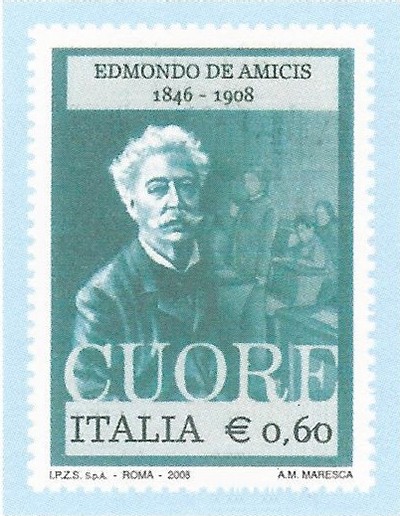
The commemorative stamp of Heart issued for the 100th anniversary of the death of Edmondo De Amicis.
Released in mid-October, Heart immediately meets a resounding success, as never before any other book had achieved. After a few days it begins to be sold at 1.000 copies a day, a pace it holds for a few weeks. At the end of the year the book is already at the 41st thousand. Afterwards, sales continue to rise steadily and in 1910 the book reaches half a million copies. Many people are learning Italian just to be able to read Heart. In the two months following the release there are 18 requests for translations, which rise shortly after to 25 and then there are still more, in practically every language in the world. In 1936 all the covers of the translated book appear in an exhibition, on the occasion of the fiftieth anniversary of the book's release.
But the editorial fortune of Heart it does not stop at these figures. In 1916 the book reached 750.000 copies, in 1923 one million; since then it has continued to be reprinted by Treves until 1938 and by Garzanti since 1939, when the latter takes over the publishing activity. And the more time passes, the more the book sells, with an inverse progression to what usually happens, when over the years a book generally tends to reduce its sales. For Heart the opposite is happening, which demonstrates how De Amicis' book has entered deeply and deeply rooted in the educational, social and cultural fabric of the country for generations and generations.
The last stage of life
In the following years De Amicis devoted himself mainly to journalism, an activity he had been carrying out for some time, and which had been enriched by a very profitable collaboration, which the attentive De Amicis was very keen on: a contract with the Argentinean "Nacional", for the which composes a weekly article.
"Work of little effort", wrote to his Florentine "mother" Emilia Peruzzi, wife of the mayor and politician Ubaldino Peruzzi, paid with the respectable sum of 8.000 lire a year, a very high sum at the time, equal to about eight times the annual salary of a state teacher. And, if we want to make some other comparison with the literary "purse", we recall that for a novel Salgari in these years received 350 lire per novel and Invernizio 600 lire.
The meeting with our poor migrants
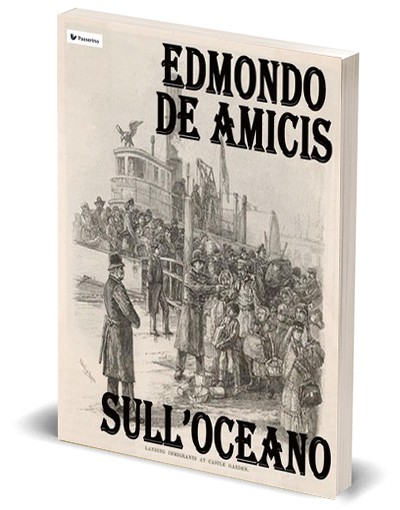
The novel On the Ocean by De Amicis marks the beginning of a profound political rethinking of the writer which will lead him to arrive at socialist convictions.
De Amicis kept this collaboration until 1893, when due to the financial difficulties of the newspaper he had to interrupt it and switch to another Argentine newspaper.
In April 1884 he went in person to Argentina and Brazil to give a series of conferences to the emigrants, for whom he had already been acclaimed for some time. It is during the outward journey, carried out on a normal line vessel, that De Amicis gets to know the world of migrants, the desperate protagonists of one of the most painful chapters of our history. The discovery of the painful reality of emigration leads him to describe this phenomenon in strong colors in a book, On the Ocean of 1889, which also marks the beginning of a profound political rethinking of the author. As a result of it, in 1890 De Amicis adhered to socialism with full conviction and prepared the novel First of May, which given for imminent and soon to be published in the same Treves catalog of 1891, will then remain incomplete and will not be published again until our times. It will only be published posthumously in 1980.
Other novels from this final phase by the author, who has yet to turn 50 and is therefore at the height of his creative vigor, are The novel of a master of 1890, love and gymnastics of 1892, The teacher of the workers of 1895, Everyone's carriage of 1899, The polite language of 1906 and another dozen works between major and minor. All, more or less, rewarded by the favor of the public, which makes the literary and artistic career of this writer absolutely unique in our literary panorama, in terms of success and sales.
Political commitment in socialism

The novel First of May, which marks De Amicis's full adherence to the socialist ideal, was published posthumously in 1980. The writer's adherence to socialism caused many problems in his family relations and is recognized as one of the causes of his son's suicide.
In recent years, the author's political commitment to the ideal of socialism has considerably accentuated, of which he is one of the major apostles and supporters at a national level.
Editorially speaking, this takes the form of numerous pamphlets and booklets, often the result of conferences and speeches, whose titles remain emblematic on the subject: On the social question in 1892, The progressive imbecility of the so-called cultured bourgeoisie in 1893, Workers at the polls in 1894, Observations on the social question in 1895, In the Enemy Camp: A Letter to a Young Socialist Worker, Socialism and homeland e The enemies of socialism in 1896, Socialism in the family: the cause of the desperate in 1897, To the enemies of socialism in 1899 and others. Sometimes these texts of a few dozen pages are published in volumes, merged with others of greater consistency.
His adherence to the cause of socialism, which demonstrates, as we said at the beginning, how incomplete and partial the image traditionally held of De Amicis is, contributes to stormy relations with his wife and the disintegration of the family. And this will be one of the reasons for the suicide of his eldest son Furio, who kills himself in 1898 at the age of 22, with the agony that one can easily imagine for his parent.
De Amicis survived him by exactly 10 years. He died in 1908, at the age of 62.

